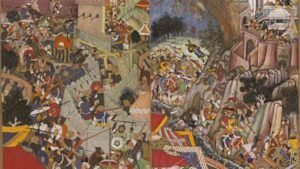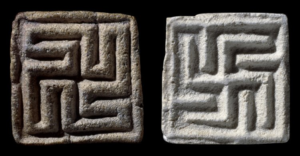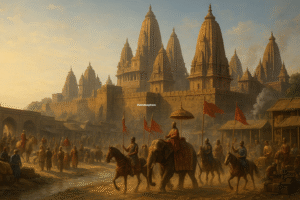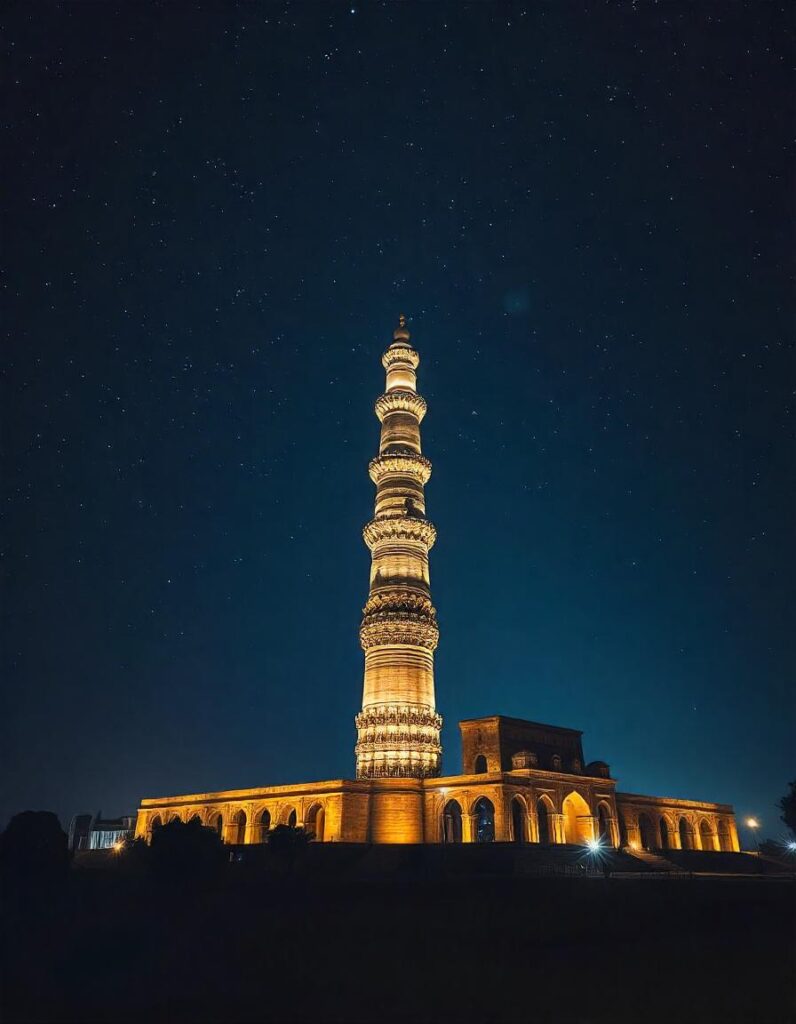
The Untold Story of Qutub Minar: Built on the Ruins of Hindu and Jain Temples
The Qutub Minar, an iconic structure and UNESCO World Heritage Site in Delhi, stands tall as a testament to the architectural brilliance of medieval India. While it is celebrated as one of the greatest achievements of the Delhi Sultanate, the story of its construction is far more complex and controversial. Beneath the grandeur of this 12th-century tower lies a history of destruction and cultural transformation, where Hindu and Jain temples were demolished to pave the way for the Qutub Minar and its surrounding complex.
The Architectural Grandeur of the Qutub Minar
Rising to a height of over 72 meters, the Qutub Minar is one of the tallest brick minarets in the world. Its construction began in 1192 CE, commissioned by Qutb-ud-din Aibak, the first ruler of the Delhi Sultanate, and was completed by his successors. The minar is an awe-inspiring blend of Islamic architectural principles and local craftsmanship. Its five tapering stories, adorned with Quranic inscriptions, geometric patterns, and floral motifs, showcase a mastery of design and engineering.
The Qutub Minar is part of the larger Qutub Complex, which includes the Quwwat-ul-Islam Mosque, the Alai Darwaza, the Iron Pillar, and several other structures. At first glance, the complex appears as a harmonious celebration of Islamic architecture. But a closer look at the mosque and its surrounding monuments reveals an unsettling truth: much of this splendor was built atop the ruins of demolished Hindu and Jain temples, with their materials and artistry forcibly co-opted into the new Islamic structures.
A Story of Destruction and Forced Replacement
The Qutub Complex did not emerge on a blank slate. Long before the arrival of Qutb-ud-din Aibak and his forces, the site was home to a thriving cultural and religious center, adorned with Hindu and Jain temples constructed between the 9th and 11th centuries CE. These temples, dedicated to deities like Vishnu, Shiva, and Jain Tirthankaras, stood as symbols of the region’s spiritual and artistic heritage.
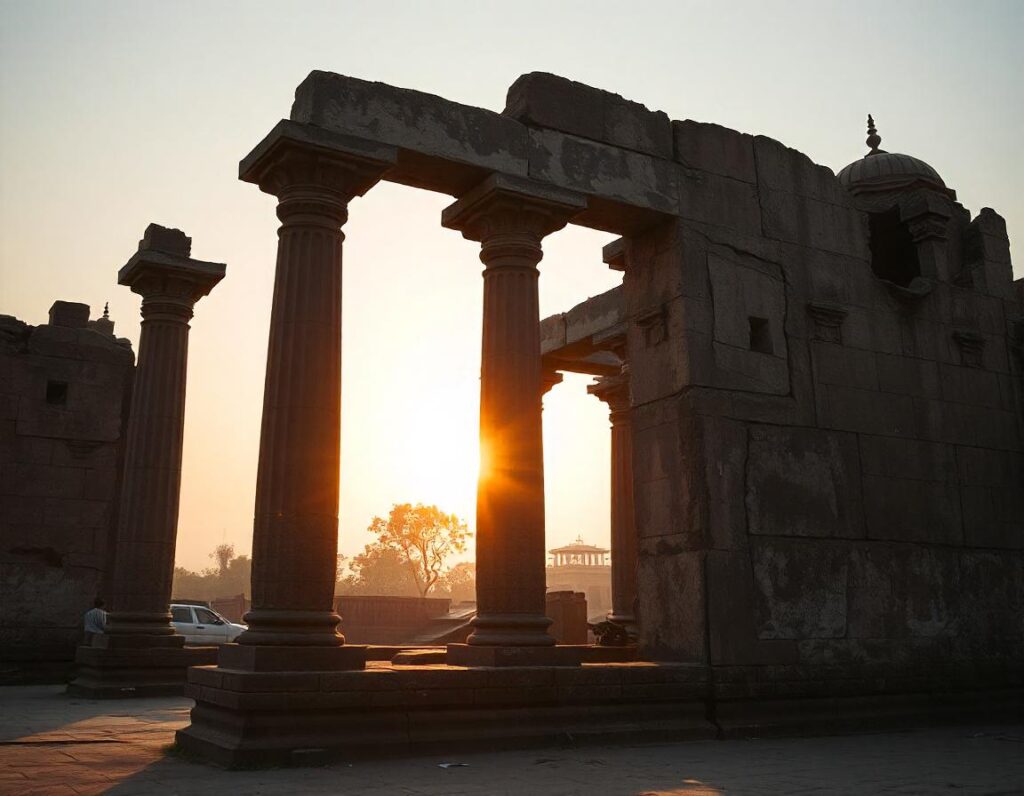
When Qutb-ud-din established the Delhi Sultanate, he and his armies razed these temples to the ground. An inscription on the Quwwat-ul-Islam Mosque chillingly commemorates this act of destruction, boasting that the mosque was built using materials from “twenty-seven temples” that had been demolished. The very pillars and columns of the mosque bear the unmistakable carvings of Hindu and Jain iconography—floral designs, mythological scenes, and depictions of deities—repurposed to serve the architectural demands of the conquerors.
This act of destruction was not merely about constructing new buildings; it was about domination. By obliterating the sacred spaces of the indigenous population and reusing their artistic symbols in a context alien to their original meaning, the conquerors humiliated the local populace. It was a deliberate attempt to erase their identity, instilling a sense of inferiority and submission.
Evidence of the Destruction of Hindu and Jain Temples
Historical records and archaeological evidence strongly suggest that the site of the Qutub Minar was originally home to several Hindu and Jain temples, which were razed during Qutb-ud-din Aibak’s conquest of Delhi. These temples, dating back to the 9th and 11th centuries CE, were not only demolished but also repurposed in the construction of the Qutub Complex.
Reused Materials in the Quwwat-ul-Islam Mosque
The Quwwat-ul-Islam Mosque, located adjacent to the Qutub Minar, is the oldest surviving mosque in India and was built using materials from 27 Hindu and Jain temples. This fact is explicitly recorded in an inscription on the mosque itself. The mosque’s pillars and columns bear carvings of Hindu deities, floral motifs, and geometric patterns—elements that are unmistakably Indic in origin. These intricate designs were left intact but were stripped of their religious context to serve the mosque’s new purpose.
Archaeological Remnants of Temples
Fragments of idols and other temple structures have been discovered in and around the Qutub Complex. These remnants, which include intricately carved statues of Hindu gods and Jain Tirthankaras, align stylistically with temple architecture from pre-Islamic India. Their presence further underscores the transformation of the site from a center of Hindu and Jain worship to an Islamic monument.
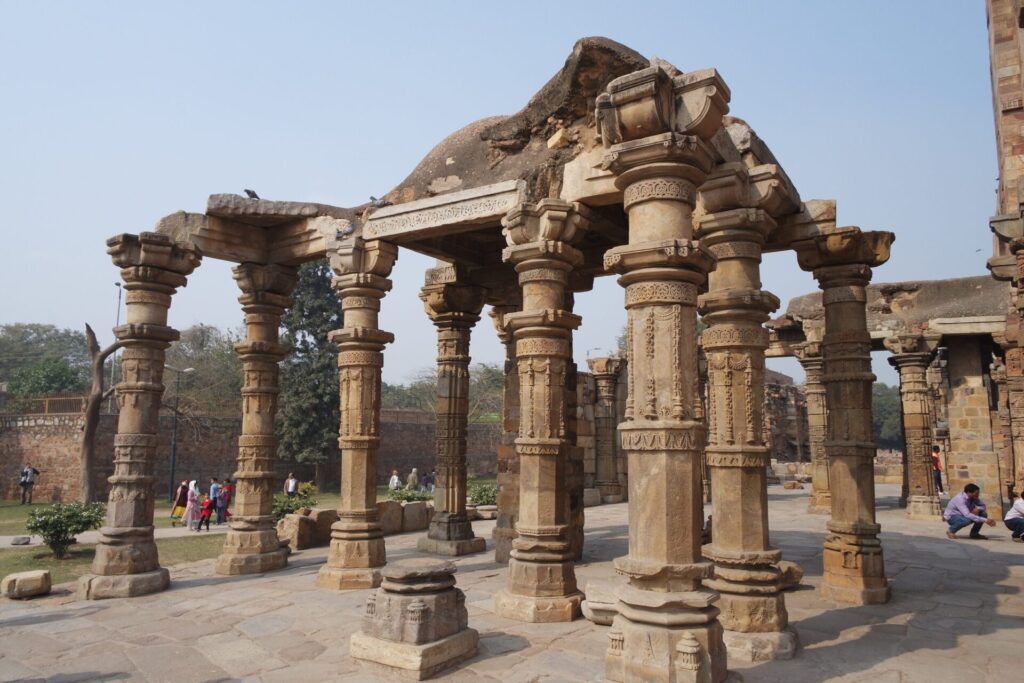
The Iron Pillar: A Witness to a Lost
EraOne of the most striking remnants of the pre-Islamic period within the Qutub Complex is the Iron Pillar. Believed to have been erected during the reign of Chandragupta II (circa 4th century CE), the pillar is a testament to the advanced metallurgical skills of ancient India. Its inscription in Sanskrit praises Hindu deities and kings, standing as a silent witness to the era before the conquest.
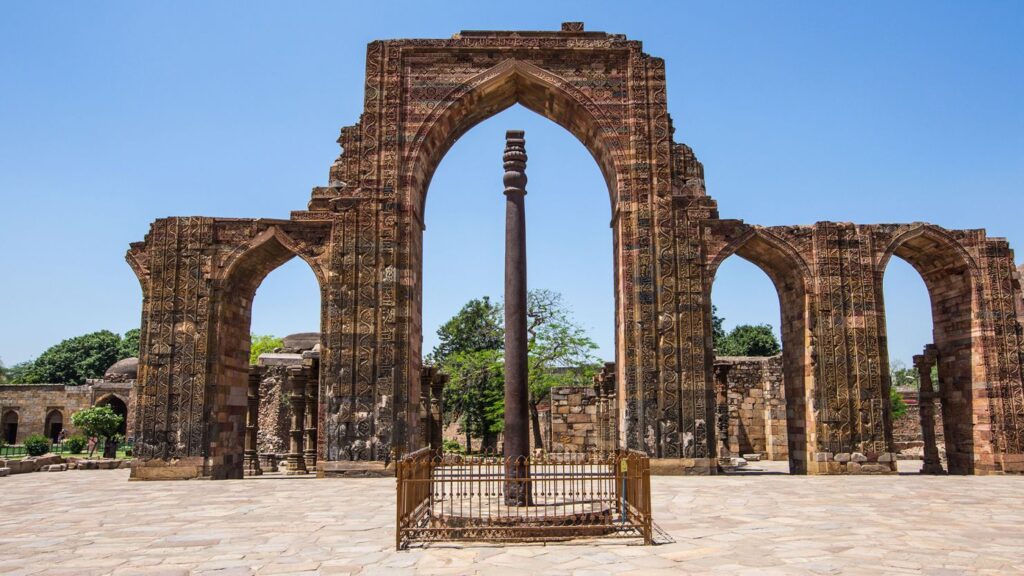
The Iron Pillar, left standing amidst the ruins, is an anomaly in a complex otherwise dedicated to celebrating Islamic rule. It serves as a poignant reminder of the cultural richness that once defined the region and the violence that sought to erase it.
The Original Temples and Their Legacy
The temples destroyed to build the Qutub Complex were likely dedicated to prominent Hindu deities such as Vishnu and Shiva, as well as Jain Tirthankaras. These temples, built in the Nagara style of North Indian architecture, would have been adorned with detailed carvings depicting mythological stories, celestial beings, and sacred symbols. Such artistry was characteristic of the period between the 9th and 11th centuries CE, a time when temple-building reached its zenith in India.
The destruction of these temples was not merely an act of practical resource use; it was a calculated political and religious move to assert the dominance of the new Islamic rulers over the indigenous population and their cultural heritage.
The Human Cost of Conquest
The construction of the Qutub Minar and the accompanying mosque was part of a larger pattern of persecution that defined the early years of the Delhi Sultanate. The indigenous Hindu and Jain populations faced forced conversions, massacres, and the systematic destruction of their cultural and religious heritage. Temples—central to the spiritual and communal life of the people—were not only destroyed but their materials were used to build structures that proclaimed the dominance of the new rulers.
The psychological impact of this cultural colonization was profound. The deliberate desecration of sacred spaces and the appropriation of temple materials for a new religious order sent a clear message: the indigenous culture was to be erased, its people subjugated, and its symbols humiliated. The sight of their once-venerated temple pillars now forming the framework of a mosque would have been a constant reminder of their defeat and the loss of their cultural sovereignty.
The Political and Religious Motivations
The demolition of temples and the construction of Islamic structures in their place were common practices among the conquerors of medieval India. These acts served dual purposes:
- Symbolism of Supremacy: The destruction of temples and the erection of mosques and minars on the same sites were symbolic of the triumph of Islam over native religions. By repurposing the materials from these temples, the conquerors left an indelible mark of their dominance.
- Pragmatism: Using materials from existing structures saved time and resources, allowing the rulers to focus on consolidating their power.
The inscription on the Quwwat-ul-Islam Mosque explicitly boasts of the destruction of 27 temples, reflecting the pride the rulers took in their actions as a form of cultural conquest.
The Dual Legacy of the Qutub Minar
The Qutub Minar stands as a paradox. On one hand, it is an extraordinary architectural achievement that reflects the ingenuity of its creators and the skills of the craftsmen who worked on it. On the other hand, it is a symbol of colonization, built on the destruction of the temples that once graced the site and the persecution of the local population.
For the indigenous people, the construction of the Qutub Minar was not just the erection of a new monument but a deliberate attempt to overwrite their history. The triumphal nature of the minar, towering over the ruins of Hindu and Jain temples, was a visual declaration of conquest and subjugation.
Qutub Minar Legacy – Why Remember This History?
It is essential to remember the full history of the Qutub Minar—not just as an architectural marvel but as a site that bears witness to the horrors of colonization. Recognizing this dual narrative does not diminish the artistic brilliance of the monument; rather, it provides a more honest and comprehensive understanding of its legacy.
The Qutub Minar’s history reminds us of the resilience of indigenous cultures that, despite immense persecution, continue to thrive. It also challenges us to confront the uncomfortable truths about the methods of conquest and colonization that shaped much of the world’s history.
As we admire the Qutub Minar today, we must also remember the temples it replaced, the people it humiliated, and the culture it sought to erase. Only by acknowledging this layered history can we truly appreciate the complexities of India’s past and the enduring spirit of its people.


